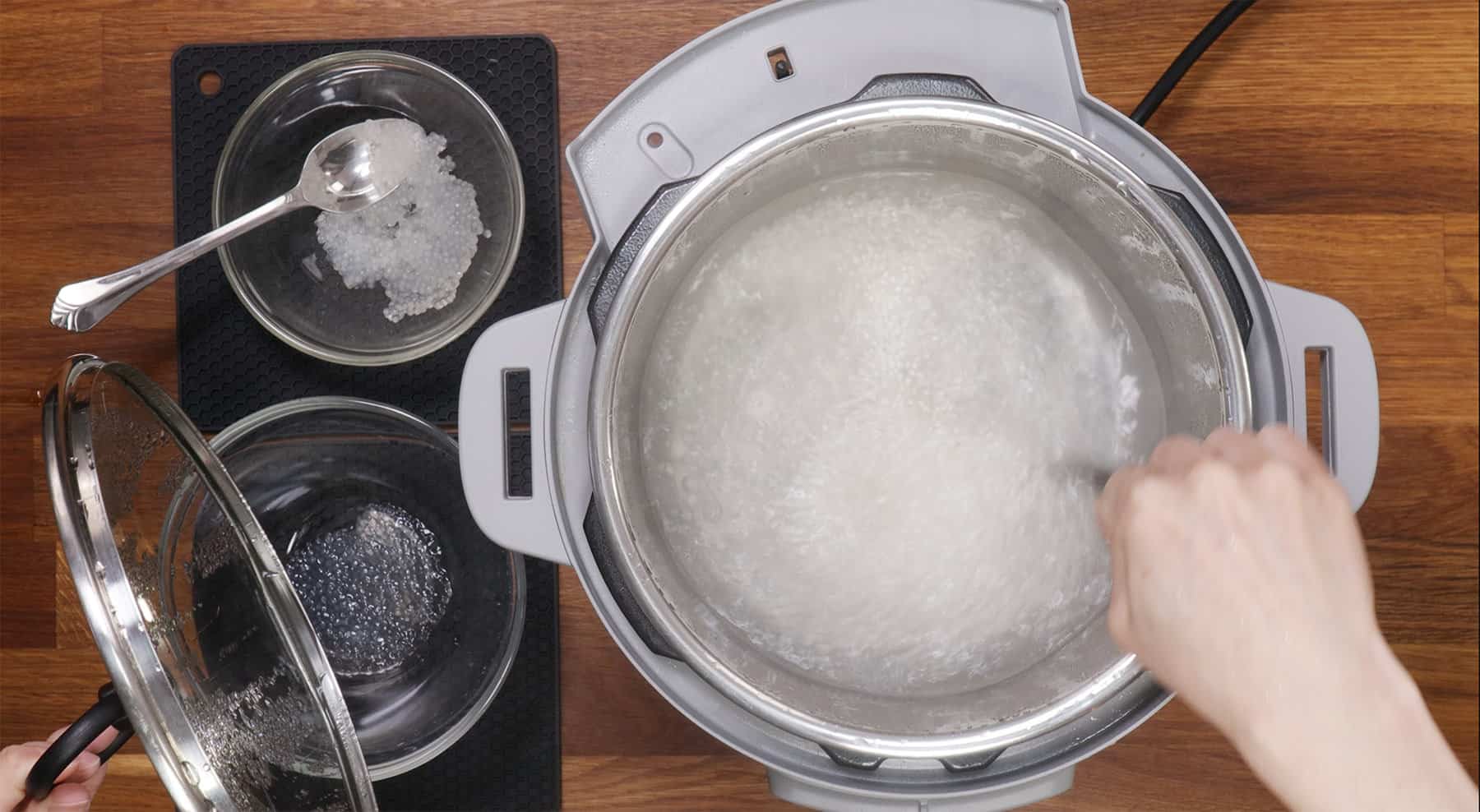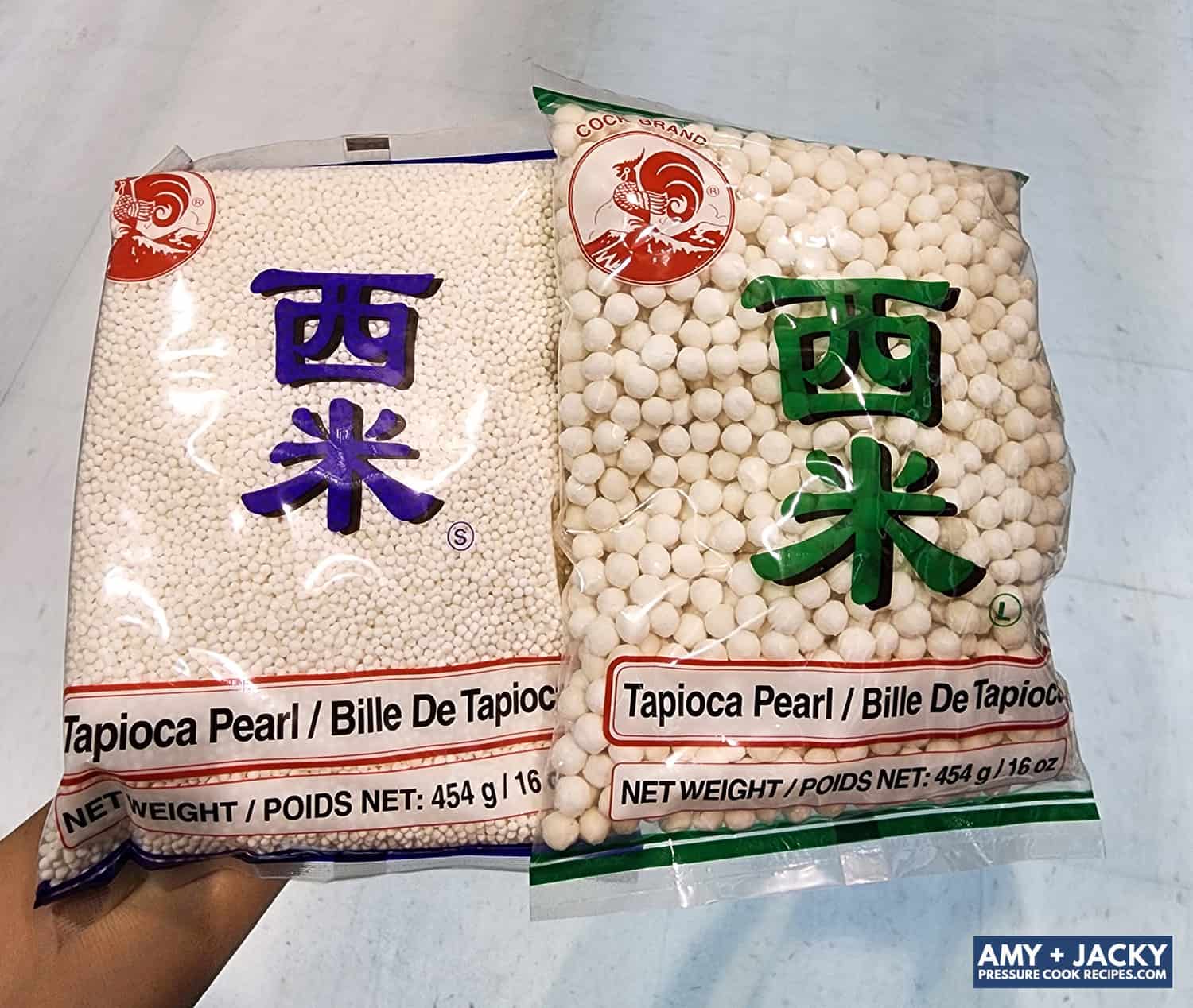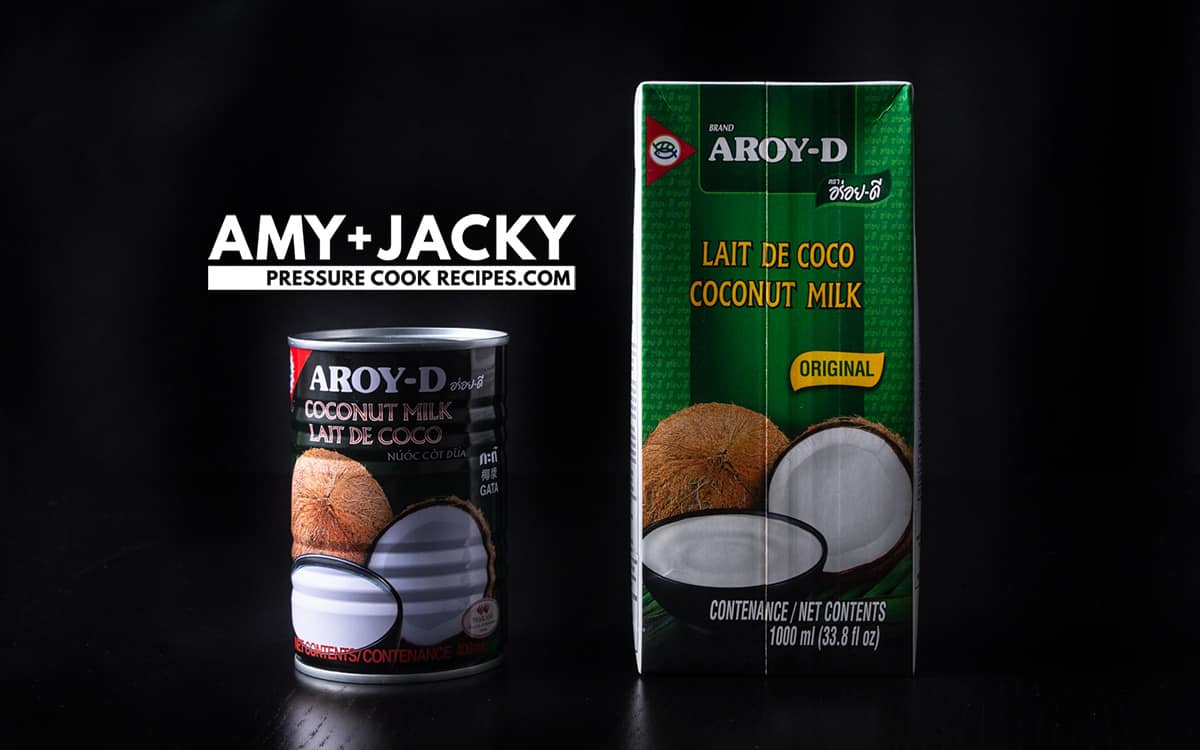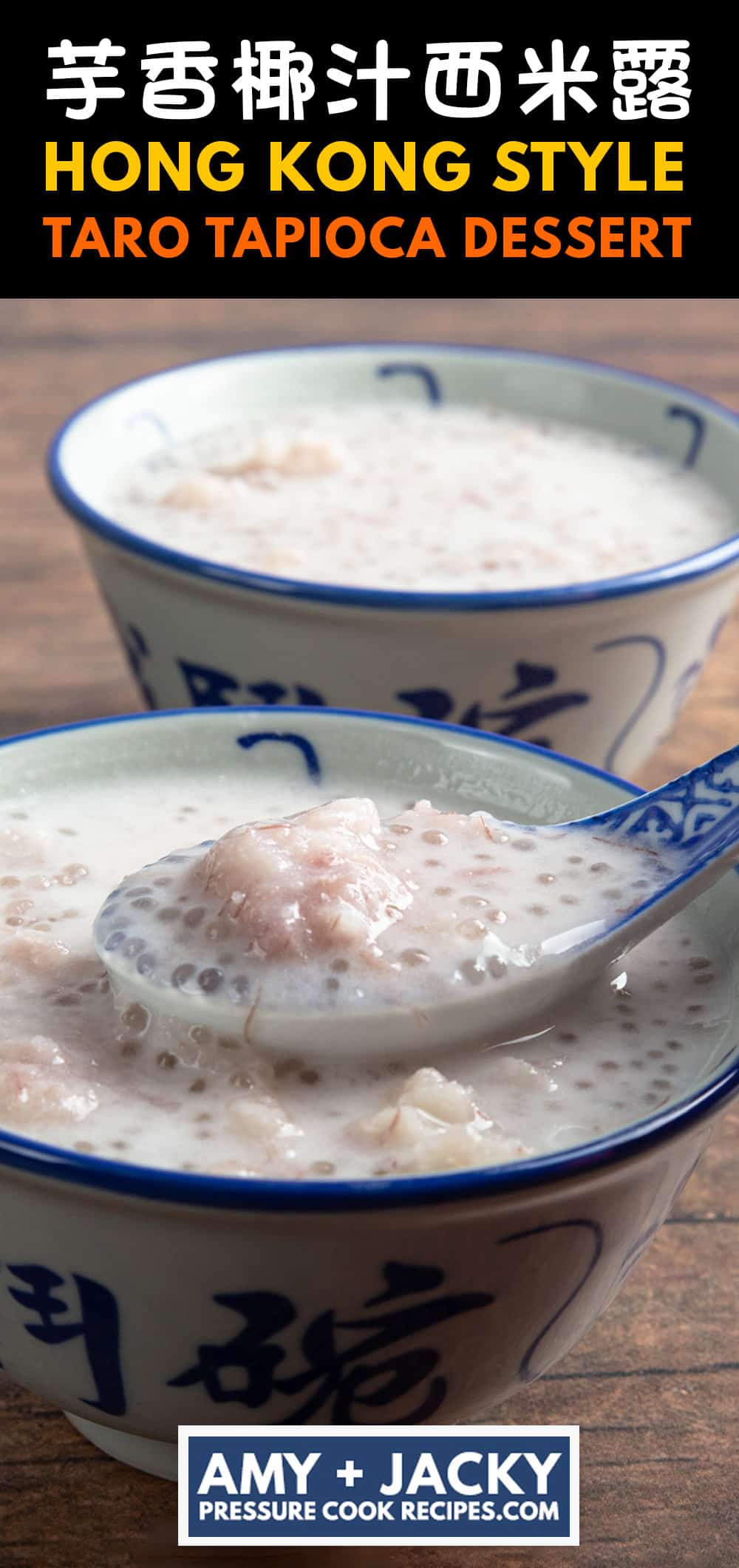Step-by-Step Guide on how to make Taro Sago (芋香椰汁西米露). Easy to make this popular Chinese Tapioca Dessert with a few simple ingredients. Hearty tender taro immersed in creamy sweet coconut milk with bouncy tapioca pearls that delicately melt in your mouth. Bursting with deliciously sweet aroma and satisfying mouthfeel. Savor this delightfully heartwarming or refreshing dessert!

Taro Sago (芋香椰汁西米露)
Taro Sago, also known as taro sai mai lou (芋頭西米露), is a popular dessert soup (tong sui; 糖水) in Hong Kong-style cuisine.
Mainly made of taro, small tapioca pearls (西米), and coconut milk.
It’s one of the many variations of the classic Chinese tapioca dessert (西米露).
The creamy sweet coconut milk is slightly thickened with nutty taro. Filled with tiny melty tapioca pearls and hearty taro chunks.
You can enjoy this nourishing taro tapioca dessert hot, warm, or cold. You can even freeze them to make tasty popsicles!

Amy + Jacky’s Test Kitchen Experiment – Taro & Small Tapioca Pearls
It’s quite tricky to perfectly cook the tiny tapioca pearls.
It’s easy to overcook them – the pearls will become mushy, sticky, and turn into a slimy blob. When undercooked, the pearls are hard with opaque white core.

We did 8+ tests cooking taro and small tapioca pearls separately to find the best methods, cooking times, and liquid ratios to make Taro Sago.
Our goal is to find that tasty sweet spot!
We experimented with cooking tapioca pearls in Instant Pot with:
- High Pressure vs. Low Pressure
- Soak vs. No Soak Tapioca Pearls
- Soak cooked tapioca pearls in cold water for different lengths of time
- Different amount of water
- Different cooking times
- Natural Pressure Release vs. Quick Pressure Release
Conclusion: The tapioca pearls were way too overcooked with various High Pressure or Low Pressure methods. We found using the “Saute High” method yield the best results. The tapioca pearls were perfectly cooked and retained the bounciness and satisfying al dente texture.

What we look for in a tasty bowl of Taro Tapioca Dessert
- Taro: Fully cooked to the core and softened, breaks apart easily, but the shape is still intact and not disintegrated; aromatic, hearty, flavorful, sweet, nutty.
- Tapioca Pearls: Fully cooked to the core, not too soft or mushy, with a little satisfying bounciness where they’ll melt in your mouth as you chew on them.
- Soup
- Texture: Creamy and somewhat thick & hearty (not thin & watery). Sometimes, we find the ones at restaurants or dessert shops to be a bit watery and thin. So we purposely designed the recipe to have some of the taro disintegrate and blend into the soup. This provides a more satisfying mouthfeel.
- Flavors & Aroma: A balance of sweet, coconutty, and nutty taro flavors; very fragrant – delicious & pleasant aroma from coconut and taro.
How to Make Taro Sago

Prepare the few ingredients for cooking taro tapioca dessert.

Taro (芋頭)
Taro is a starchy root vegetable commonly used in Asian cuisine. It has a slightly sweet and nutty flavor. If you’re familiar with Hawaiian food, the Hawaiian side dish “Poi” is made of Taro root!
- If you enjoy Taro, you can also make this tasty Taro Milk.
The 0.75″ cubes will dissolve and blend into the cooking liquid (act as a natural thickener). While the 1″ cubes will stay more intact for you to bite into as you enjoy the soup.

Small Tapioca Pearls (西米)
Tapioca pearls are made from tapioca starch, which comes from cassava root.
When cooked, these tiny white balls become soft and translucent pearls with some bouncy chew. It’s commonly used in desserts and beverages to add texture.
- These are not the same as the brown boba pearls, tapioca balls, or bubble tea pearls.
- For this Taro Sago recipe, make sure you’re using the small white tapioca pearls 西米 (as shown on the left in photo below).

Coconut Milk (椰漿)

We experimented with canned coconut milk (left) and boxed 100% unsweetened coconut milk (right). Both worked great, but flavor-wise, we like the boxed version a little more.
For the best flavors for this chinese tapioca dessert, use one that lists 100% coconut milk as the ingredient. Not diluted with water or other ingredients.
Rock Sugar (黃冰糖)
Rock sugar is raw cane sugar. It’s a staple pantry ingredient for Asian cooking. It’s used in dishes like Pho, Hong Kong Style Beef Stew, Taiwanese Beef Noodle Soup, and Three Cup Chicken. It’s especially great for balancing flavors in stews or soups.
*Note: Yellow Rock Sugar is not the same as Rock Candy.
- Substitute: If you can’t find Yellow Rock Sugar, you can substitute it with the same amount of granulated sugar.
Tools for Making Taro Sago
Cook Tapioca Pearls
Bring 4 cups (1L) water to a rolling boil with the Instant Pot “Saute High” setting.
Add 125g small tapioca pearls in Instant Pot. Stir occasionally to avoid the tapioca pearls sticking to the bottom of the pot.

Cook tapioca pearls in boiling water for 7 minutes.
Turn off the heat. Then, use the “Keep Warm” button (residual heat) to further cook the tapioca pearls for another 8 to 9 minutes until they’re fully translucent.
Rinse cooked tapioca pearls in cold water, then drain well with a fine mesh strainer.

Pressure Cook Taro
If you used Instant Pot to cook tapioca pearls, rinse off all the residue starch with water, and dry off the inner pot.
Add 1 pound (454g) taro cubes, ⅜ teaspoon (3g) fine salt, 90 grams rock sugar, and 2 tablespoons (25g) granulated sugar in Instant Pot. Add 4 cups (1L) cold tap water to Instant Pot.

Close the lid, then turn Venting Knob to Sealing Position.
Instant Pot Taro Cook Time: Pressure Cook taro at High Pressure for 1 minute, then Natural Release for 6 minutes.

After 6 minutes of Natural Release, release the remaining pressure by turning the Venting Knob to the Venting position. You may want to use the Gradual Release method as cooked taro can be starchy.
Remove the lid carefully.
Add Coconut Milk and Cooked Tapioca Pearls

Add 400ml coconut milk in Instant Pot. Stir a few times very gently with a ladle to mix in the coconut milk. Don’t stir it too much because it might break down all the cooked taro.

Bring the taro coconut milk mixture back to a simmer by pressing the “Cancel” button, then “Saute” button.
When the taro coconut milk mixture starts simmering, add cooked tapioca pearls in Instant Pot. Gently stir a few more times to mix in the cooked tapioca pearls.

Season & Serve Instant Pot Taro Tapioca
Once the Instant Pot taro tapioca is back to a simmer, taste and add more sugar if desired.
You can enjoy this delicious taro tapioca dessert hot, warm, or cold.

What to Serve with Taro Sago
Taro Sago is a Hong Kong-style dessert mostly enjoyed as a snack in the afternoon, dessert after dinner, or a sweet late night treat!
You can enjoy a Hong Kong-style meal and serve taro tapioca dessert with these tasty main dishes, side dishes, and soups.
- Main Dishes: Instant Pot Char Siu, Instant Pot White Cut Chicken, Instant Pot Spare Ribs and Rice, Instant Pot HK Beef Curry, Instant Pot Soy Sauce Chicken, Instant Pot Chinese Lamb Stew
- Soups & Congee: Instant Pot Chicken Congee, Instant Pot HK Borscht Soup, Pork Shank Carrots Soup
- Side Dishes: Instant Pot Chinese Sticky Rice, Chinese Broccoli with Oyster Sauce (Gai Lan)
Enjoy Hong Kong Style Taro Tapioca Dessert!

Taro Sago (芋香椰汁西米露)
Ingredients
- 125 grams small tapioca pearls (西米)
- 1 pound (454g - 500g) taro (芋頭) , 0.75” - 1” cube
- ⅜ teaspoon (3g) fine salt
- 90 grams rock sugar (黃冰糖) + 25 grams granulated sugar
- 4 cups (1000ml) cold tap water
- 1 can (400ml) coconut milk (椰漿)
Equipment
- Instant Pot Pressure Cooker (6qt) (Can use Stovetop)
♥ Share this Recipe so We can create more yummy recipes for you. Thank you 🙂
Instructions
- Cook Tapioca Pearls: Bring 4 cups (1L) water to a rolling boil with the Instant Pot "Saute High" setting. Add 125g tapioca pearls in Instant Pot. Stir occasionally to avoid the tapioca pearls sticking to the bottom of the pot. Cook tapioca pearls in boiling water for 7 minutes. Turn off the heat. Then, use "Keep Warm" button (residual heat) to further cook the tapioca pearls for another 8 to 9 minutes until they're fully translucent. Rinse cooked tapioca pearls in cold water, then drain well with a fine mesh strainer.Cooking Time Tip (see notes): Monitor and adjust the residual heat cooking time according to your tapioca pearls.
- Pressure Cook Taro: If you used Instant Pot to cook tapioca pearls, rinse off all the residue starch with water, and dry off the inner pot. Add 1 lb (454g) taro cubes, ⅜ tsp (3g) fine salt, 90g rock sugar, and 2 tbsp (25g) granulated sugar in Instant Pot. Add 4 cups (1L) cold tap water in the Instant Pot. Close the lid, then turn Venting Knob to Sealing Position. Pressure Cook at High Pressure for 1 minute, then Natural Release for 6 minutes. After 6 minutes of Natural Release, release the remaining pressure by turning the Venting Knob to the Venting position (use Gradual Release method). Remove the lid carefully.
- Add Coconut Milk and Cooked Tapioca Pearls: Add 400ml coconut milk in Instant Pot. Stir a few times very gently with a ladle to mix in the coconut milk. Amy + Jacky's Tip: Don't stir it too much because it might break down all the cooked taro. Bring taro coconut milk mixture back to a simmer by pressing the "Cancel" button, then "Saute" button. You can cover it with a glass lid to speed up the process.When the taro coconut milk mixture starts simmering, add cooked tapioca pearls in Instant Pot. Gently stir a few more times to mix in the cooked tapioca pearls.
- Season & Serve: Once the Taro Sago is back to a simmer, taste and add more sugar if desired.You can serve this tasty nourishing dessert hot, warm, or cold. Enjoy~
Notes
- Substitute: You can substitute it with the same amount of granulated sugar.
Nutrition
Other Chinese Dessert Recipes
- Red Bean Soup (紅豆沙)
- HK Egg Custard (超滑鮮奶燉蛋)
- Tofu Pudding (豆腐花)
- Black Sesame Soup (香滑芝麻糊)
- Chinese Sweet Potato Soup (番薯糖水)
All Our Pressure Cooker Recipes
*Disclosure: We are an Amazon Influencer/Amazon Associate. This means that if you decide to purchase items or services on Amazon through our links on Pressure Cook Recipes to Amazon, Amazon will send a small commission to us at no additional costs to you. Thank you!

